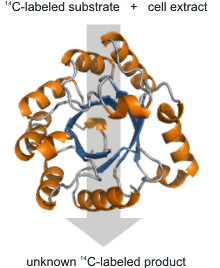Functional assignment of uncharacterised enzymes
The sequencing of numerous bacterial genomes has led to the identification of a large number of unknown genes. The functional assignment of the proteins encoded by these genes is an inherently difficult but important task for molecular biology. We are focussing on novel enzymes that are evolutionarily related to well-studied model enzymes. Using a combination of computational biology, biochemistry and genetics, we aim to gain insights into the evolution of novel enzymatic activities and to uncover previously unknown biosynthetic pathways.
We are currently working on RNA-binding enzymes and the family of PcrB proteins. In addition to their "main job" as enzymes, i.e. catalytic activity, RNA-binding enzymes bind to RNAs as a "moonlighting function". This enables them to regulate other processes in the cell or, conversely, to be regulated by the binding RNA. Such processes have already been relatively well studied in eukaryotes, but are largely unknown in prokaryotes. We have therefore set ourselves the goal of investigating the frequency of such interactions in bacteria and characterising individual case studies in more detail.
PcrB is a key enzyme in a new biosynthetic pathway that produces acetylated ether lipids in bacteria. Ether lipids have long been regarded as a unique feature of archaea, as their membrane phospholipids are composed of sn-glycerol-1-phosphate (G1P) with two ether-linked isoprenoids. In contrast, bacterial (and eukaryotic) phospholipids are based on sn-glycerol-3-phosphate (G3P) esterified with two fatty acids. A key step in the synthesis of archaeal ether lipids is the stereospecific transfer of the polyprenyl moiety from geranylgeranyl diphosphate (GGPP, 20 C atoms) to G1P, catalysed by geranylgeranylglyceryl phosphate synthase (GGGPS). We were able to show that PcrB, an orthologue of GGGPS found in bacteria, also synthesises ether lipids, but is a heptaprenylglyceryl phosphate synthase (35 C atoms). PcrB and GGGPS share the frequently encountered (βα)8-barrel fold. We are currently investigating the variability within the PcrB/GGGPS enzyme family in terms of structural features, catalytic activity and substrate specificity. We are also investigating how bacterial ether lipids are further processed by acetylation and what biological significance they have.

Publications
- Peterhoff, David, Zellner, Hermann, Guldan, Harald, Merkl, Rainer, Sterner, Reinhard and Babinger, Patrick (2012) Dimerization determines substrate specificity of a bacterial prenyltransferase.
Chembiochem : a European journal of chemical biology: 13 (9), P. 1297-1303.
https://dx.doi.org/10.1002/cbic.201200127 - Kropinski, Andrew M, Van den Bossche, An, Lavigne, Rob, Noben, Jean-Paul, Babinger, Patrick and Schmitt, Rüdiger (2012) Genome and proteome analysis of 7-7-1, a flagellotropic phage infecting Agrobacterium sp H13-3.
Virology Journal: 9 (1)
https://dx.doi.org/10.1186/1743-422X-9-102 - Guldan, Harald, Matysik, Frank-Michael, Bocola, Marco, Sterner, Reinhard and Babinger, Patrick (2011) Functional Assignment of an Enzyme that Catalyzes the Synthesis of an Archaea-Type Ether Lipid in Bacteria.
Angewandte Chemie International Edition: 50, P. 8188-8191.
https://dx.doi.org/10.1002/anie.201101832 - Guldan, Harald, Sterner, Reinhard and Babinger, Patrick (2008) Identification and characterization of a bacterial glycerol-1-phosphate dehydrogenase: Ni(2+)-dependent AraM from Bacillus subtilis..
Biochemistry: 47 (28), P. 7376-84.
https://dx.doi.org/10.1021/bi8005779 - Burghardt, Tillmann, Saller, Manfred, Gürster, Sonja, Müller, Daniel, Meyer, Carolin, Jahn, Ulrike, Hochmuth, Eduard, Deutzmann, Rainer, Siedler, Frank, Babinger, Patrick, Wirth, Reinhard, Huber, Harald and Rachel, Reinhard (2008) Insight into the proteome of the hyperthermophilic Crenarchaeon Ignicoccus hospitalis: the major cytosolic and membrane proteins.
Archives of microbiology: 190 (3), P. 379-394.
https://dx.doi.org/10.1007/s00203-008-0399-x
